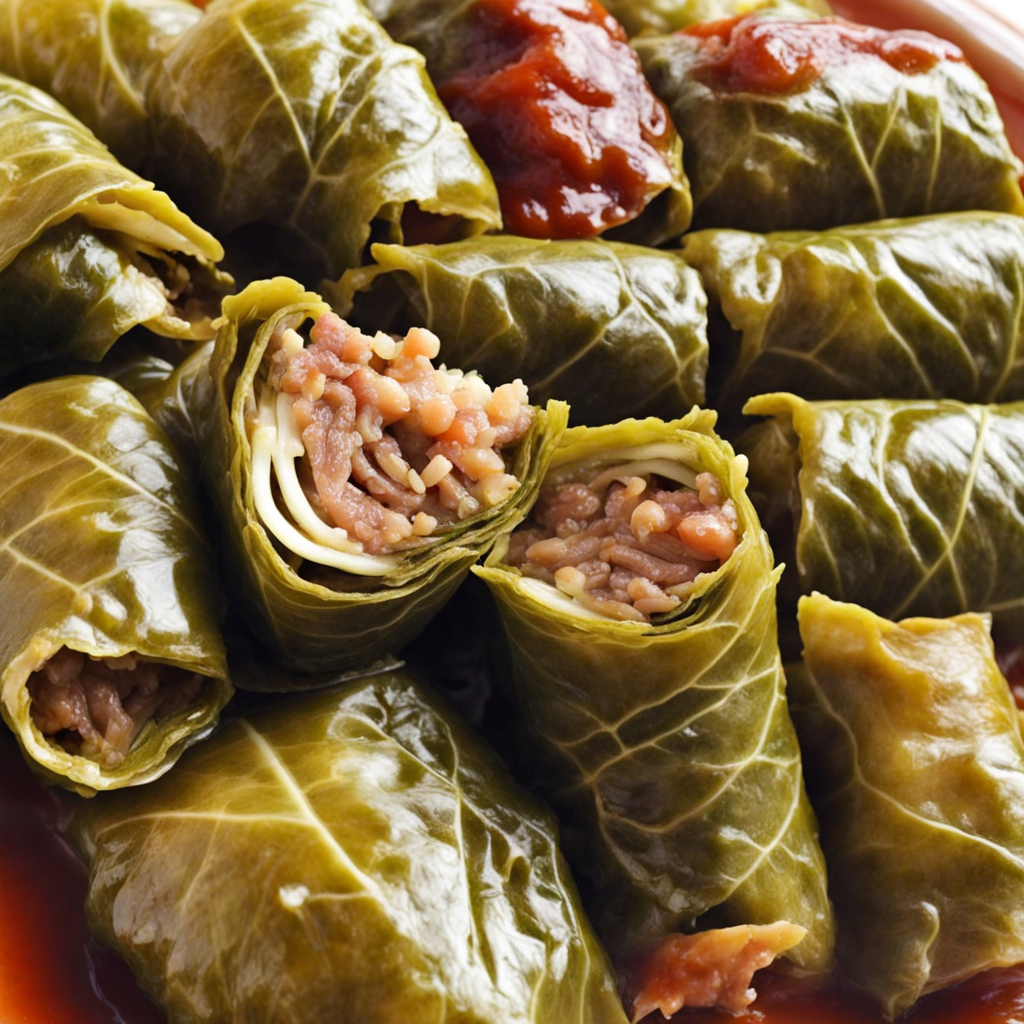Shopska Salad
Shopska Salad is a vibrant and refreshing dish that captures the essence of North Macedonian cuisine. This salad is a colorful medley of fresh vegetables, primarily featuring ripe tomatoes, crunchy cucumbers, bell peppers, and red onions. Each ingredient is diced into bite-sized pieces, creating a delightful mix of textures and flavors. The bright colors of the vegetables not only make the dish visually appealing but also highlight the freshness of the local produce, making it a staple in many Macedonian households, especially during the summer months. One of the key components that truly distinguishes Shopska Salad is the generous topping of crumbled white cheese, known as feta or sirene. This creamy and slightly tangy cheese adds a rich depth to the salad, balancing the crispness of the vegetables with its rich flavor. A drizzle of high-quality olive oil and a splash of vinegar complete the dish, enhancing the natural flavors of the ingredients while imparting a subtle Mediterranean flair. The simplicity of the dressing allows the freshness of the vegetables to shine through, making each bite a celebration of taste. Shopska Salad is not just a side dish; it's a culinary experience that embodies the spirit of conviviality and sharing in North Macedonia. Often served as an appetizer, it pairs wonderfully with grilled meats or as part of a larger mezze spread. Its refreshing qualities make it an ideal choice for a warm day, providing both nourishment and satisfaction. Whether enjoyed at a local tavern or made at home, Shopska Salad offers a delightful taste of North Macedonian culture that invites food lovers to explore new flavors and textures.
How It Became This Dish
The History of Шопска салата: A Culinary Icon of North Macedonia Introduction Шопска салата, known as Shopska salad in English, is a vibrant and flavorful dish that is an essential part of the culinary tradition of North Macedonia and the broader Balkan region. This refreshing salad, primarily composed of tomatoes, cucumbers, onions, bell peppers, and topped with crumbled white cheese, embodies the essence of the Mediterranean lifestyle. The origins of Shopska salad are deeply intertwined with the region's history, culture, and agricultural practices, making it more than just a meal; it is a symbol of identity and community. Origins and Early Influences The roots of Shopska salad can be traced back to the agricultural practices of the Balkan peoples, particularly those residing in the region that encompasses modern-day North Macedonia, Bulgaria, and Serbia. The name “Shopska” is derived from the “Shops,” a term referring to the inhabitants of the region known as Shopluk, which includes parts of Bulgaria and North Macedonia. This area has historically been agrarian, with fertile lands that have produced a bounty of fresh vegetables and herbs, making salads a staple in local diets. The salad’s ingredients reflect the Mediterranean climate, which is conducive to the growth of tomatoes, cucumbers, and peppers. These vegetables are not only staples of the Balkan diet but also represent the vibrant colors and flavors of the region. The use of white brined cheese, similar to feta, is a defining feature of Shopska salad, enhancing its flavors and providing a creamy texture. It is believed that the salad began to gain popularity in the mid-20th century, coinciding with the post-World War II era when regional identities were being redefined in the face of changing political landscapes. Cultural Significance Shopska salad holds a special place in Macedonian culture, often served as a starter or side dish in traditional meals. The salad is commonly enjoyed with grilled meats, especially during the summer months at outdoor gatherings and barbecues, known as “roštilj.” Its refreshing nature makes it an ideal companion to the hearty flavors of grilled meats, reflecting the communal spirit of dining in Macedonia. In addition to its culinary role, Shopska salad symbolizes the region's agricultural heritage and the importance of fresh, seasonal produce. The salad is often featured in celebrations, family gatherings, and national holidays, serving as a reminder of the rich natural resources of the land. Its preparation is often a communal activity, bringing families and friends together to enjoy the fruits of their labor, further solidifying its status as a cultural artifact. Development Over Time Over the decades, Shopska salad has evolved while remaining true to its roots. The dish has become increasingly popular across the Balkans, with each country adding its own variations. In Bulgaria, for instance, it is a staple in many households and is often served in restaurants, showcasing the regional pride associated with the dish. Variations may include the addition of olives, herbs like parsley, or even a drizzle of olive oil, reflecting local tastes and preferences. With globalization, Shopska salad has crossed borders and gained recognition beyond the Balkans. It is now commonly found in Balkan restaurants across Europe and North America, catering to expatriates and those seeking to experience traditional Balkan cuisine. This international exposure has led to a fusion of flavors, with chefs experimenting with the basic recipe to create modern interpretations. For example, some contemporary versions may incorporate ingredients such as avocados or different types of cheese, appealing to health-conscious diners and those looking for a twist on the classic. Modern-Day Relevance Today, Shopska salad is more than just a dish; it represents a cultural heritage that has withstood the test of time. In North Macedonia, it is often associated with the national identity, serving as a culinary ambassador of the country. The salad has even gained attention as a part of the country's efforts to promote its gastronomy on the international stage. Festivals celebrating traditional foods often feature Shopska salad as a highlight, emphasizing its role in the nation’s culinary landscape. Additionally, the rise of the farm-to-table movement has renewed interest in traditional dishes like Shopska salad. Many people are now more conscious of the origins of their food and prefer locally sourced, seasonal ingredients. This trend aligns perfectly with the philosophy behind Shopska salad, which relies on fresh produce and simple preparation methods. As a result, more Macedonian and Balkan restaurants are showcasing authentic recipes that honor the traditional ways while embracing modern dining preferences. Conclusion In summary, Shopska salad is not merely a dish; it is a vibrant representation of North Macedonian culture and history. Its origins in the fertile lands of the Balkans, its role in community gatherings, and its evolution over time reflect the dynamic nature of culinary traditions. As Shopska salad continues to be enjoyed and celebrated, it serves as a reminder of the importance of food in forging identity, fostering community, and preserving cultural heritage. Whether enjoyed at a family gathering, a festive celebration, or a restaurant halfway across the world, Shopska salad remains a beloved emblem of the Balkans, a testament to the region's rich agricultural bounty and culinary ingenuity.
You may like
Discover local flavors from North Macedonia







